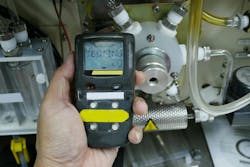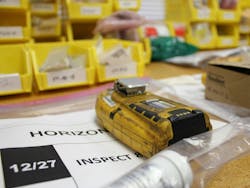When Gas Detectors Expire: How to Avoid Safety Risks and Dispose of Equipment the Right Way
Disposing of gas detection equipment can be deceptively complex for EHS managers, facility supervisors and maintenance personnel. Gas detectors contain hazardous materials (e.g., lead, mercury or electrochemical sensors) that require specialized e-waste handling. Simply tossing them in the trash risks environmental contamination and may violate local disposal laws. Expired calibration gases are also classified as hazardous waste and have their own set of disposal protocols.
Across industries, disposal procedures are often informal or undocumented and can result in expired detectors in storage, missing disposal records or outdated vendor agreements. When active hazards take precedence over day-to-day operations, it’s easy for end-of-life equipment handling to take a back seat.
Don’t wait for audits or inspections to expose these gaps. Build a proactive disposal plan that includes the following steps.
Poor Storage Shortens Equipment Life: Why Safe Disposal Starts Long Before Expiration
Proper storage is often the most overlooked step in managing gas detection equipment through its full lifecycle. How you store gas detectors and calibration gases directly affects how long they last and how safe they are to handle after expiration.
For instance, most electrochemical sensors have a shelf life of six to 12 months when stored between 68 and 77°F (20 and 25°C) and away from high humidity. This temperature range helps preserve the integrity of the electrolyte and other sensitive components within the sensor. Similarly, calibration gases (especially reactive blends) can degrade or depressurize before their printed expiration date if not kept upright in a cool, dry and ventilated environment.
Here are some essential practices to extend safe usability and simplify end-of-life handling:
- Label inventory with shelf life and expiration dates. Clearly marking each item with both its shelf life and expiration date helps teams monitor gas stability and avoid using degraded or unsafe supplies. Shelf life refers to how long a product can be stored before use, while expiration (or lifespan) indicates how long it remains effective once activated or deployed.
-
Secure with mounting brackets or wall chains. To prevent tipping, leaks or accidental damage, store gas detectors and calibration gases in their original packaging until they’re ready for use. Use wall-mounted brackets, racks or chains to keep cylinders upright and stable, especially in high-traffic or vibration-prone areas where unsecured containers pose a safety risk.
-
Implement a first-in, first-out (FIFO) system. Organize your inventory so that older stock is used before newer items. This simple rotation method helps minimize waste, ensures calibration gases and sensors are used within their effective lifespan, and reduces the likelihood of discovering expired equipment during audits or inspections.
Treating storage as part of your disposal plan fosters a “start smart, end safe” culture. It also minimizes surprises during inventory reviews or inspections.
When No One Owns it, Everyone is at Risk: Why Clear Roles are Critical for Safe Disposal
Gas detection equipment disposal works best when it’s a shared responsibility among EHS managers, facility supervisors and maintenance personnel.
Here’s how teams can take ownership and streamline the process:
-
Assign clear roles. Designate who’s responsible for identifying expired equipment, who handles storage and who coordinates with disposal vendors. This division of labor prevents last-minute scrambles, ensures accountability, streamlines communication and reinforces a proactive safety culture.
-
Create a disposal checklist. A clear, step-by-step checklist ensures consistency, reduces errors and keeps disposal tasks from falling through the cracks, especially in busy facilities with rotating staff. Include essential actions such as removing lithium-ion batteries, devalving the cylinder and ensuring it’s empty and without pressure, documenting serial numbers, and verifying vendor handoff procedures. Post the checklist in shared workspaces and embed it in digital standard operating procedures (SOPs) so it’s always within reach. This practice not only streamlines training and hand overs but also reinforces accountability and compliance during audits or inspections.
-
Schedule quarterly inventory reviews. Waiting for an audit to uncover expired gas detectors or calibration gases is a reactive approach that can lead to compliance violations, wasted resources or even safety risks. By proactively reviewing your inventory every quarter, teams can identify aging equipment before it becomes a liability, rotate stock more efficiently and ensure that all devices in use are within their functional lifespan.
Proactively assigning disposal oversight to a specific role, backed by a documented process, helps ensure expired materials are handled promptly and properly. It also reinforces a strong culture of accountability—where safety doesn’t end when equipment stops working.
Avoid Fines and Safety Risks: How to Dispose of Gas Detectors and Calibration Gases the Right Way
Once gas detectors and calibration gases reach the end of their usable life, these items are often considered hazardous waste due to their chemical makeup, pressurized components or embedded electronics. Mishandling them can result in fines, environmental liabilities or even workplace accidents.
Here’s how to dispose of them safely and responsibly:
-
Segregate components into their raw components. Gas detectors often contain lithium batteries, electrochemical sensors, circuit boards and casings made of mixed materials. Lithium-ion batteries, for instance, pose fire and environmental risks if not fully depleted and handled correctly. Even partially discharged batteries can spark fires if tossed into standard waste streams. As such, these components should be removed and sorted according to local e-waste, battery recycling and hazardous materials guidelines. If you’re unsure, refer to the device’s Material Safety Data Sheet (MSDS) for instructions.
-
Devalve and depressurize calibration gas cylinders. Before disposal, all calibration gas cylinders should be fully emptied and depressurized. Use manufacturer-approved tools (e.g., C-10 or CGA 600 devalver, depending on cylinder size and type) to release residual gas safely. Once empty, mark the cylinder clearly and follow local guidelines for recycling or disposal. Some vendors may accept returned cylinders for reuse or recycling.
-
Partner with certified e-waste recyclers or disposal vendors. Partner with a certified electronics recycling facility or hazardous waste vendor familiar with industrial safety equipment. These providers can handle the separation, neutralization or safe destruction of toxic components and help ensure compliance with the U.S. Environmental Protection Agency (EPA), Occupational Safety and Health Administration (OSHA) and local regulations. Some vendors may offer mail-in disposal services for retired gas monitors. This service ensures proper dismantling and disposal while minimizing administrative burden.
-
Document the disposal process. Maintain records that show when and how each piece of equipment was disposed of, who handled the task, and which vendor or facility processed it. Having this documentation on hand can be invaluable during audits or environmental compliance reviews.
This deliberate approach allows even the busiest facilities to close the loop on gas detection safety and avoid costly missteps.
Compliance Without the Guesswork: The Value of a Trusted Disposal Partner
Even with the best internal protocols, gas detection equipment disposal can quickly become overwhelming without the appropriate support. That’s where experienced vendors come in—not just as service providers but as strategic partners who understand the nuances of hazardous waste regulations, e-waste handling and calibration gas disposal.
Here’s what to look for when selecting a safety equipment partner:
-
Review certifications. Work with vendors that are certified in e-waste recycling, hazardous materials handling or industrial gas cylinder disposal. Ask if they comply with EPA Resource Conservation and Recovery Act (RCRA) standards, OSHA regulations and local environmental laws. The ideal vendor should act as an extension of your safety team, not just a supplier.
-
Ask about take-back or mail-in programs. Vendors may offer mail-in disposal services for expired gas monitors. These programs simplify logistics for remote or multisite operations and ensure each item is properly dismantled and processed.
-
Insist on a transparent process and documentation. A qualified vendor should walk you through their disposal process and provide clear documentation, including manifests or certificates of destruction. This paperwork is vital for audits, internal reporting or insurance claims.
-
Find a vendor that offers comprehensive support. Look for vendors that provide end-of-life evaluations, equipment upgrade recommendations or inventory tracking support. The perfect vendor also helps you extend equipment life with services that include calibration, repairs and parts replacement.
With the right safety equipment partner, you can focus on what matters most—protecting your people and keeping operations running smoothly—without getting bogged down by administrative hurdles or regulatory guesswork.
When gas detectors expire, a smart disposal plan protects your people, your compliance record and your peace of mind.
About the Author

Rick Pedley
Rick Pedley is president and CEO of PK Safety, a supplier of occupational safety and personal protective equipment since 1947.

